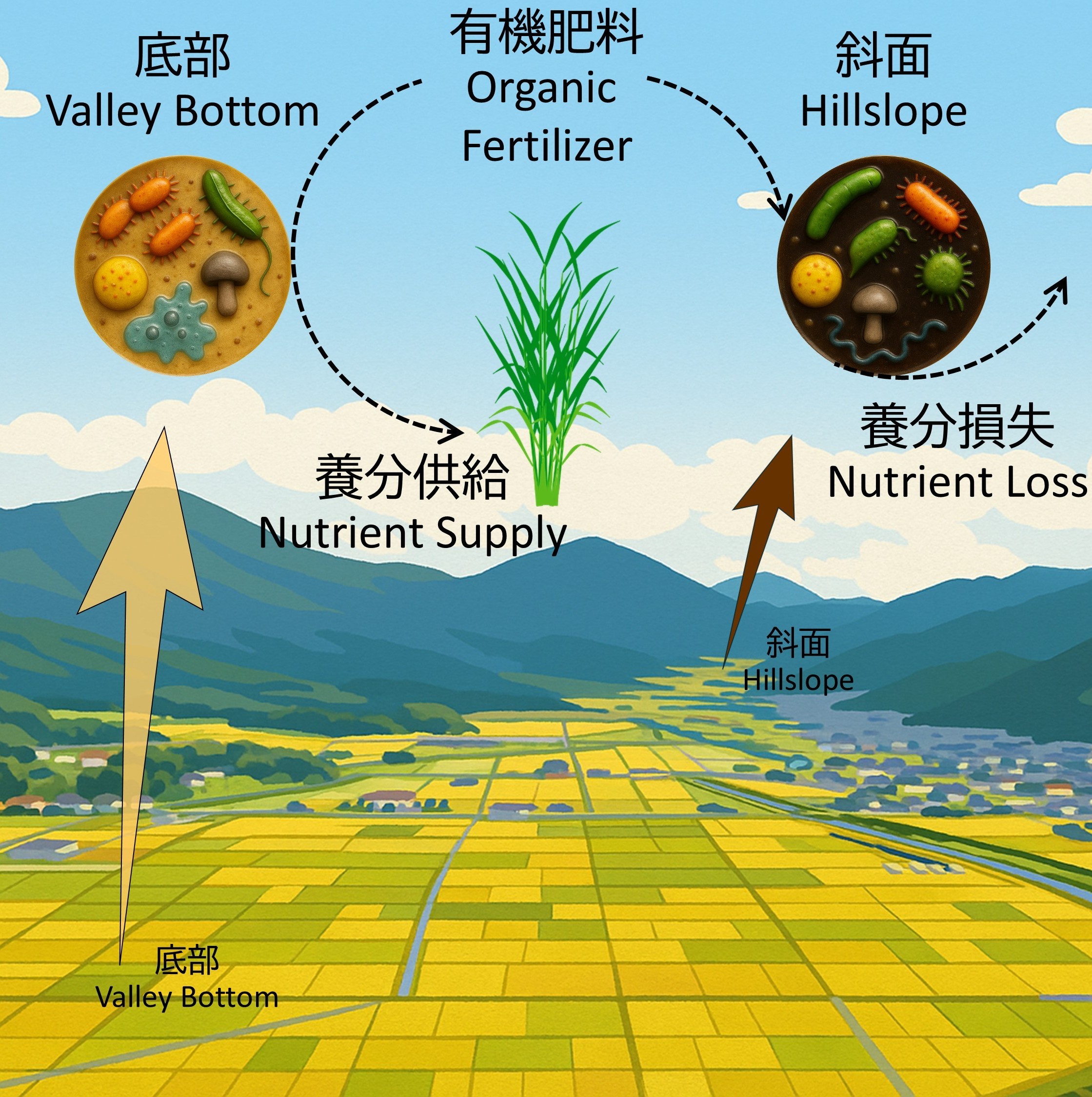足掛け7年にわたり、与謝野町で取り組んできた研究の成果を公表することができました。
京都府与謝野では、域内で調達された食品系廃棄物から「京の豆っこ肥料」という有機肥料が製造されています。この地域循環型有機肥料を使って栽培されたコシヒカリは、「京の豆っこ米」として販売され、地域で愛され続けています。
亀岡先生(現三重大学名誉教授)にお誘い頂き、私が与謝野町スマートグリーンビレッジ確立協議会に参加したのは2019年のことです。与謝野町の主要な産業である農業、特にコメ生産を科学的に発展させることが大きな目標の一つでした。協議会に参加する生産者からは、京の豆っこ肥料の施肥技術改善や、この肥料が地力に与える影響の解明など、幾つか要望が出されていました。
与謝野町は町内全域が加悦谷に立地しています。その加悦谷において、底部と斜面の農家水田を対象に、土壌微生物群集解析、土壌培養試験、現地栽培試験を実施しました。その結果、底部の水田土壌では斜面に比べて、微生物による脱窒やアンモニア利用に関わる遺伝子の存在割合が少なく、京の豆っこ肥料由来の窒素がより効率的に水稲に利用されていることが明らかになりました。実際に農家水田で栽培試験を実施したところ、やはり底部の水田が斜面に比べて水稲へ窒素を効率的に供給し、結果的に玄米収量を向上させることが立証されました。これは、有機米を生産する際に地形に起因した土壌微生物群集を考慮する必要性があることを初めて示した研究です。
協議会参加から足掛け7年。この間、未曾有のコロナ禍を何とか乗り切り、留学生を含めて大勢の学生が関わった一大プロジェクト。その集大成に相応しい成果になったと自負しています。
Culmination
After seven years of work, we have been able to publish the results of our research conducted in Yosano Town. In Yosano, Kyoto Prefecture, an organic fertilizer called “Kyo-no-Mamekko Fertilizer” is produced from food waste procured within the region. Rice (Koshihikari) cultivated using this regionally-circulated organic fertilizer is sold as “Kyo-no-Mamekko Rice” and continues to be beloved in the local community.
It was in 2019 when Professor Kameoka (currently Professor Emeritus at Mie University) invited me to join the Yosano Town Smart Green Village Establishment Council. One of the major goals was to scientifically advance agriculture, particularly rice production, which is Yosano Town’s main industry. Producers participating in the council had made several requests, including improvements to fertilization techniques for Kyo-no-Mamekko fertilizer and elucidation of the effects this fertilizer has on soil fertility.
Yosano Town is entirely located in the Kaya Valley. Within this valley, we conducted soil microbial community analysis, soil cultivation experiments, and field cultivation trials targeting paddy fields of farmers located both at the valley bottom and on the hill slopes. The results revealed that paddy soils at the bottom had lower proportions of genes involved in microbial denitrification and ammonia utilization compared to those on slopes, indicating that nitrogen derived from Kyo-no-Mamekko fertilizer was more efficiently utilized by rice plants. When we actually conducted cultivation experiments in farmers’ paddy fields, we confirmed that bottom paddy fields supplied nitrogen to rice plants more efficiently than slope fields, consequently improving brown rice yield. This research was the first to demonstrate the necessity of considering topography-induced soil microbial communities when producing organic rice.
Seven years since joining the council. During this period, we somehow survived the unprecedented COVID-19 pandemic, and this major project involved many students, including international students. I take pride in the fact that this represents a fitting culmination of our efforts.

 using WordPress and
using WordPress and
Comments are closed